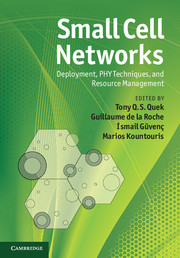Book contents
- Frontmatter
- Contents
- List of contributors
- Foreword by David Chambers
- Acknowledgments
- Acronyms
- 1 Small cell networks overview
- 2 Fundamentals of access control in femtocells
- 3 Coverage analysis using the Poisson point process model
- 4 Interference modeling for cognitive femtocells
- 5 Multiple antenna techniques in small cell networks
- 6 Physical layer techniques for cognitive femtocells
- 7 Femtocell coverage optimization
- 8 Random matrix methods for cooperation in small cell networks
- 9 Mobility in small cell networks
- 10 Cognitive radio resource management in autonomous femtocell networks
- 11 Decentralized reinforcement learning techniques for interference management in heterogeneous networks
- 12 Resource allocation optimization in heterogeneous wireless networks
- 13 New strategies for femto-macro cellular interference control
- 14 Femtocell interference control in standardization
- 15 Spectrum assignment and fairness in femtocell networks
- 16 Self-organization and interference avoidance for LTE femtocells
- Index
- References
13 - New strategies for femto-macro cellular interference control
Published online by Cambridge University Press: 05 May 2013
- Frontmatter
- Contents
- List of contributors
- Foreword by David Chambers
- Acknowledgments
- Acronyms
- 1 Small cell networks overview
- 2 Fundamentals of access control in femtocells
- 3 Coverage analysis using the Poisson point process model
- 4 Interference modeling for cognitive femtocells
- 5 Multiple antenna techniques in small cell networks
- 6 Physical layer techniques for cognitive femtocells
- 7 Femtocell coverage optimization
- 8 Random matrix methods for cooperation in small cell networks
- 9 Mobility in small cell networks
- 10 Cognitive radio resource management in autonomous femtocell networks
- 11 Decentralized reinforcement learning techniques for interference management in heterogeneous networks
- 12 Resource allocation optimization in heterogeneous wireless networks
- 13 New strategies for femto-macro cellular interference control
- 14 Femtocell interference control in standardization
- 15 Spectrum assignment and fairness in femtocell networks
- 16 Self-organization and interference avoidance for LTE femtocells
- Index
- References
Summary
Femto-macro interference coordination problem
Femtocells are small wireless access points that are typically installed in a subscriber's premises, but operate in a cellular provider's licensed spectrum. Since femtocells can be manufactured at a very low cost, require minimal network maintenance by the operator, and can leverage the subscriber's backhaul, femtocells offer the possibility of expanding cellular capacity at a fraction of the cost of traditional macrocellular deployments. With the surge in demand for wireless data services, femtocells have thus attracted considerable recent attention, both in cellular standards bodies such as the 3rd Generation Partnership Project (3GPP) [1–3] and academic research [4, 5].
However, one of the key technical challenges in deploying femtocells is the interference between the underlay of small femtocells and the overlay of comparatively large macrocells – an issue raised in virtually every survey on femtocells [5–8]. While interference is a fundamental challenge in any cellular system, the so-called cross-tier interference in femtocell networks has two particularly challenging aspects:
1. Strong and varied interference: Due to closed access or restricted association, mobile terminals (or user equipment (UE) in 3GPP terminology) may not be able to connect to a given femtocell even when it provides the closest serving base station [9]. Such restrictions can result in strong interference both from the macrocell UE transmitter onto the femtocell uplink and from the femtocell downlink onto the macrocell UE receiver. In addition, since the femtocell access points are often deployed in an essentially ad hoc manner, interference conditions are much more varied than traditional planned macrocellular networks.
- Type
- Chapter
- Information
- Small Cell NetworksDeployment, PHY Techniques, and Resource Management, pp. 311 - 331Publisher: Cambridge University PressPrint publication year: 2013

